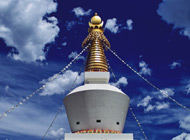The stupa is the oldest Buddhist religious monument. In prehistoric times, stupas were simply mounds of earth and stones (tumuli) – places to bury important kings away from the village. Twenty-five-hundred years ago, at the time of Shakyamuni Buddha’s death, a change came about in the way stupas were regarded.
The Buddha requested that his relics be placed in a familiar stupa, but with a shift in emphasis. Instead of being just a place of honor where the bones or relics of a cremated king were placed, the stupa was to be located at four corners (i.e., a crossroads), to remind people of the awakened state of mind. So, the stupa evolved from a mound of dirt (stup, Skt., “to heap up, pile, raise aloft, elevate”), to a king’s burial tomb, to a religious monument.
After the Buddha’s death, stupas evolved from being used as shrines to the dead and into places to honor the living. They were erected to remind people far into the future that they, while living, had the seed of enlightenment.
A stupa is intended to stop you in your tracks. It is an architectural representation of the entire Buddhist path. The body, speech and mind of an enlightened teacher is contained therein – a reminder of a timeless quality which one senses in old monuments. The Tibetan word for “stupa” is choten, meaning a receptacle for offerings and implying support for lay people to express devotion and connection to the Buddha mind.
Breathing Life into North American Buddhadharma
There are three basic reasons for building stupas. Burial stupas hold relics from the funeral pyre. Commemorative stupas mark the place of an event or occasion in the Buddha’s life. And, votive stupas are erected to make a dedication of good will or to accumulate merit. The latter type is a perfect outlet for lay people to connect with the Buddhadharma; in the past, it was primarily the laity who were involved in constructing stupas.
A fundamental significance of stupas in the West lies in the contrast between modern and ancient worldviews, specifically in how matter is viewed. Ancient people, living close to nature, viewed matter as living and fecund, as an accumulator of spirit. Modern people, cut off from nature, often view matter as dead, something mechanical to be used or manipulated. The stupa is monumental architecture, emphasizing our connection to the spiritual by both its mass and symbolic shapes.
The two most fundamental and enduring shapes in all stupas are the hemisphere (mound) and the cone, or spire. The hemisphere symbolizes an egg, womb or the fertile earth. This traces back to lunar religions, where the creative force of the earth (soil) as mother of all life was worshipped in caves and subterranean sanctuaries, and where the mysteries of life and creation were the center of religious attention. In this lunar type of worship, the mounds were placed away from the village.
 The cone shape is symbolic of solar worship, wherein altars were placed inside the village as an important reference point for daily life. It seems natural to erect a vertical post, such as a May pole or flagpole, to mark the Sun’s zenith. It ties together earth with heaven and represents a unifying element – a center, the life force, an axis-mundi, the lingam, or gathering place.
The cone shape is symbolic of solar worship, wherein altars were placed inside the village as an important reference point for daily life. It seems natural to erect a vertical post, such as a May pole or flagpole, to mark the Sun’s zenith. It ties together earth with heaven and represents a unifying element – a center, the life force, an axis-mundi, the lingam, or gathering place.
The combining of the lunar and solar elements into the Buddhist stupa lies at the heart of the Buddha’s instructions to place his burial stupas at four corners. It represents a combining of opposites: night and day, matter and mind, earth and sky, unconscious and conscious, inner and outer, mysterious and obvious, female and male.
 A square box called a harmika (Skt.) is placed on top of the hemisphere and below the cone. It is said to be the “dwelling place of the gods” and symbolizes a transcendent aspect of mind or aspiration – a transformation potential. In the earliest stupas, relics were found here. The harmika reflects the idea that stupas are a place where offerings can be made, blessings received and devotion practiced, such as by walking around the stupa in a clockwise direction. Circumambulating stupas is a very ancient practice that reflects the movement of the Sun, of ever-revolving seasons and the rotation of planets.
A square box called a harmika (Skt.) is placed on top of the hemisphere and below the cone. It is said to be the “dwelling place of the gods” and symbolizes a transcendent aspect of mind or aspiration – a transformation potential. In the earliest stupas, relics were found here. The harmika reflects the idea that stupas are a place where offerings can be made, blessings received and devotion practiced, such as by walking around the stupa in a clockwise direction. Circumambulating stupas is a very ancient practice that reflects the movement of the Sun, of ever-revolving seasons and the rotation of planets.
If you look down on a stupa from the sky, it always reveals a directional orientation such as South, West, North and East – a mandalic square shape. It has a central axis, the center of the universe, the axis-mundi. Two basic shapes – the circle and the square – are apparent, representing water and earth respectively, while the vertical shape – a triangle – represents fire.
The vertical shape of a Tibetan stupa evolved into a representation of the body of a Buddha seated upon a square throne. The pole inside some stupas represents the spine, an obelisk-shaped pillar made from a special tree that is inserted when construction is nearly complete.
From the very earliest days of stupas, Buddhists placed both scripts of dharani (prayers which energize the speech element, creeds, or mantra) and numerous miniature images of the stupa (tsa-tsas) inside these monuments. Vessels containing hair, fingernails, relics, and ashes of enlightened teachers were buried there along with jewels, seeds, herbs, and other earth-symbolic items.

